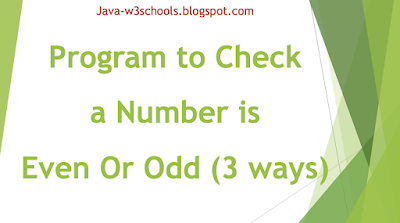1. Overview:
In this tutorial, We'll be learning about
a java program how to compare two lists and find out the unmatched contents from those two lists. We will demonstrate the
example programs in
Java and Python languages.
1.1 Example
Input:
List 1: ["File Name 1", "File Name 2", "File Name 3", "File Name 4", "File Name 5", "File Name 6", "File Name 7", "File Name 8"]
List 2: ["File Name 2", "File Name 4", "File Name 6", "File Name 8"]
Output:
Unmatched values: ["File Name 1", "File Name 3", "File Name 5", "File Name 7]
This example is for Strings. I
f the list is having custom objects such as objects of
Student, Trade or CashFlow. But in our tutorial, We will discuss for
Employee objects in the list.
We can use any
List implementation classes such as
ArrayList, LinkedList, Stack, and Vector. For now, all programs in this post are
using ArrayList implementation.
2. Java
We'll write a program
to remove the duplicates values from
list1 based on
list2 and operation seems to be more complex but if we use the
java collection API methods then our life will become easy because these methods are being tested by many developers every day.
See in our case need to find the unmatched content against
list2 from
list1.
2.1 String values
List interface has a method named "
removeAll" which takes any collection implementation class (in our example it an
ArrayList).
removeAll() method removes from the current list all of its elements that are contained in the specified collection that passed to this method as an argument.
Syntax: See the method signature below.
boolean removeAll(Collection c)
Creating two lists which are having files names in it.
// List 1 contains file names from 1 to 8.
List list1 = new ArrayList<>();
list1.add("File Name 1");
list1.add("File Name 2");
list1.add("File Name 3");
list1.add("File Name 4");
list1.add("File Name 5");
list1.add("File Name 6");
list1.add("File Name 7");
list1.add("File Name 8");
//List 2 contains only even number file names.
List list2 = new ArrayList<>();
list2.add("File Name 2");
list2.add("File Name 4");
list2.add("File Name 6");
list2.add("File Name 8");
Now we are going
to delete the file names that are already present in list 2 from list 1.
list1.removeAll(list2);
All the elements that are present in
list2 are deleted from
list1 which means all even number file names are deleted from
list1.
Let us take a look at the contents in
list1.
[File Name 1, File Name 3, File Name 5, File Name 7]
Note: If
list2 is null then will through NullPointerException.
2.2 Custom Objects
What happens if these two lists are having objects instead of String literals? Custom objects such as Employee, Student, Trade or User objects.
We will demonstrate an example with Employee object for now. The same is applicable for any type of object in the list.
Creating an Employee class with id and name.
public class Employee {
private int id;
private String name;
public Employee(int id, String name) {
this.id = id;
this.name = name;
}
// setter and getter methods.
// Overrding toString method.
@Override
public String toString() {
return "Employee [id=" + id + ", name=" + name + "]";
}
}
Creating
list1 and
list2 with employee objects.
List list1 = new ArrayList<>();
list1.add(new Employee(100, "Jhon"));
list1.add(new Employee(200, "Cena"));
list1.add(new Employee(300, "Rock"));
list1.add(new Employee(400, "Undertaker"));
List list2 = new ArrayList<>();
list2.add(new Employee(100, "Jhon"));
list2.add(new Employee(300, "Rock"));
list1 and
list2 have common employee objects for id 100 and 200 with the same name. Now we have to remove these two objects from
list1. We know that
removeAll method removes objects from
list1 comparing with
list2 objects. We'll call
removeAll method.
list1.removeAll(list2);
Now see the objects in
list1 after calling removeAll method.
[Employee [id=100, name=Jhon], Employee [id=200, name=Cena], Employee [id=300, name=Rock], Employee [id=400, name=Undertaker]]
Observe that
removeAll method is not removed duplicate objects from
list1.
To make this code work, we need
to override equals() method in Employee class as below.
@Override
public boolean equals(Object obj) {
Employee other = (Employee) obj;
if (id != other.id)
return false;
if (name == null) {
if (other.name != null)
return false;
} else if (!name.equals(other.name))
return false;
return true;
}
Why we need to override equals method is because
removeAll method internally compares the contents invoking equals() method on each object. Here the object is an employee so it calls
equals method on employee object.
Take a look at the output of
list1 now.
[File Name 1, File Name 3, File Name 5, File Name 7]
We have to notice one point here that the same code had worked in the case of String objects because String class already
overridden equals method as below.
public boolean equals(Object anObject) {
if (this == anObject) {
return true;
}
if (anObject instanceof String) {
String aString = (String)anObject;
if (coder() == aString.coder()) {
return isLatin1() ? StringLatin1.equals(value, aString.value)
: StringUTF16.equals(value, aString.value);
}
}
return false;
}
All codes are shown are compiled and run successfully in
java 12.
3. Python
In Python, finding out the unmatched contents from two lists is very simple in writing a program.
Let us have a look at the following code.
def finder(arr1,arr2):
eliminated = []
for x in arr1:
if x not in arr2:
eliminated.append(x)
else:
pass
return eliminated
We can sort two lists before
for loop as below. I have seen many developers do sorting before comparing the contents. But, actually
sorting is not necessary to do.
arr1 = sorted(arr1)
arr2 = sorted(arr2)
4. Conclusion
In this tutorial, We've explored the
way to remove the duplicate contents from list 1 against list 2 and
finding out the unmatched contents from two lists.
Further discussed
comparing two employee lists and finding out unmatched content using
removeAll method in Java and Program in Python for the same.
As usual, All examples are shown in this tutorial are available on
GitHub.




